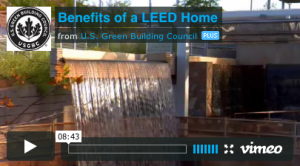Home Lighting
By Susan Bloom

Click the image above to watch the Benefits Of A LEED Home video by the U.S. Green Building Council.
Question: What renowned environmental program lays claim to over 8 billion square feet of floor space, including 2,000 schools, all newly constructed Starbucks locations, and such high-profile buildings as the Empire State Building, Sears Tower and The Pentagon?
Answer: The U.S. Green Building Council’s Leadership in Energy & Environmental Design Program, also known as LEED.
Developed by the U.S. Green Building Council in 2000 and considered the standard for green buildings, LEED is a comprehensive rating system that measures how sustainable a building is, from its energy usage to its water systems, indoor air quality, types of materials used, and landscaping strategy.
Promoting the design and construction of high-performance structures and communities, LEED principles have been incorporated into the construction and upgrade of commercial, industrial, institutional and residential buildings worldwide. With more than 15,000 LEED-certified homes in the U.S. and another 65,000 in the pipeline, could a LEED home be right for you?
A LEED certification reflects that a home’s energy performance exceeds any local code requirements by at least 15% (through such measures as energy-efficient lighting, high-efficiency HVAC systems, renewable energy and more); that it incorporates a minimum number of water efficiency measures; and that it is properly ventilated through the use of high-efficiency air filters. In addition, LEED homes minimize construction waste, incorporate environmentally preferable products, and involve a sound and thoughtful environmental strategy in terms of the landscaping.
There are four categories of LEED homes—Certified, Silver, Gold and Platinum. All levels are strictly inspected and verified to guarantee that a LEED certification represents a universally recognized seal of quality and environmental peace of mind.
According to the USGBC, while “LEED is considered the most rigorous of all the available home programs” and it can be difficult to meet LEED requirements, the results can be well worth the effort. In addition to providing a healthier environment for residents and reducing greenhouse gas emissions, LEED homes reduce energy and water consumption and costs, can often sell faster and at a higher value than non-green dwellings, and can help homeowners stand as environmental stewards and models of green behavior in their community.
Are you ready to pursue your own path of energy and environmental leadership and go for the gold … or at least the green? To get started and see if your home has what it takes to be LEED-certified, the USGBC recommends that you talk to your builder, real-estate professional, or architect about LEED or contact a “LEED for Homes” Provider in your area.
Click here to learn more.
The LEED Green Building Program: What You Need To Know
- LEED program provides rating system for green buildings, including homes
- LEED offers a tough standard for sustainability, including energy efficiency
- More than 15,000 LEED-certified homes in the U.S.